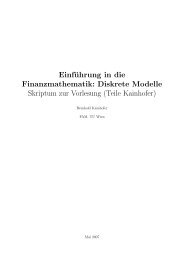LilyPond Beginnershandleiding
LilyPond Beginnershandleiding
LilyPond Beginnershandleiding
You also want an ePaper? Increase the reach of your titles
YUMPU automatically turns print PDFs into web optimized ePapers that Google loves.
Hoofdstuk 3: Fundamentele concepten 86<br />
3.4.5 Scores and parts<br />
In orchestral music, all notes are printed twice. Once in a part for the musicians, and once in a<br />
full score for the conductor. Variables can be used to avoid double work. The music is entered<br />
once, and stored in a variable. The contents of that variable is then used to generate both the<br />
part and the full score.<br />
It is convenient to define the notes in a special file. For example, suppose that the file<br />
‘horn-music.ly’ contains the following part of a horn/bassoon duo<br />
hornNotes = \relative c {<br />
\time 2/4<br />
r4 f8 a | cis4 f | e4 d |<br />
}<br />
Then, an individual part is made by putting the following in a file<br />
\include "horn-music.ly"<br />
\header {<br />
instrument = "Horn in F"<br />
}<br />
{<br />
\transpose f c' \hornNotes<br />
}<br />
The line<br />
\include "horn-music.ly"<br />
substitutes the contents of ‘horn-music.ly’ at this position in the file, so hornNotes is defined<br />
afterwards. The command \transpose f c' indicates that the argument, being \hornNotes,<br />
should be transposed by a fifth upwards. Sounding f is denoted by notated c', which corresponds<br />
with the tuning of a normal French Horn in F. The transposition can be seen in the following<br />
output<br />
4 <br />
2 <br />
<br />
<br />
In ensemble pieces, one of the voices often does not play for many measures. This is denoted<br />
by a special rest, the multi-measure rest. It is entered with a capital R followed by a duration<br />
(1 for a whole note, 2 for a half note, etc.). By multiplying the duration, longer rests can be<br />
constructed. For example, this rest takes 3 measures in 2/4 time<br />
R2*3<br />
When printing the part, multi-rests must be condensed. This is done by setting a run-time<br />
variable<br />
\set Score.skipBars = ##t<br />
This command sets the property skipBars in the Score context to true (##t). Prepending the<br />
rest and this option to the music above, leads to the following result<br />
<br />
4 2<br />
3<br />
<br />
<br />
<br />
<br />
<br />
The score is made by combining all of the music together. Assuming that the other voice is<br />
in bassoonNotes in the file ‘bassoon-music.ly’, a score is made with



